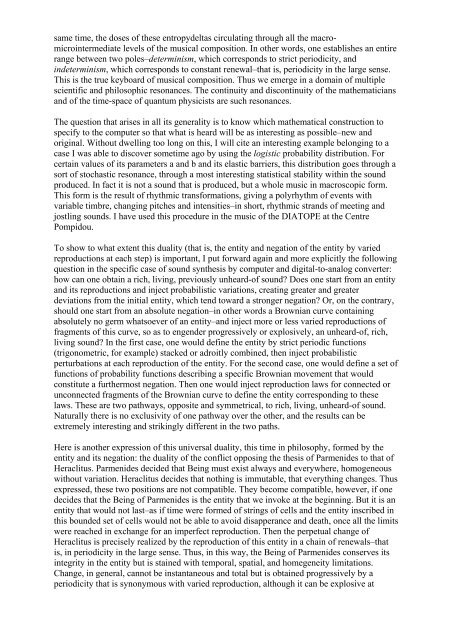Iannis Xenakis
Iannis Xenakis
Iannis Xenakis
You also want an ePaper? Increase the reach of your titles
YUMPU automatically turns print PDFs into web optimized ePapers that Google loves.
same time, the doses of these entropydeltas circulating through all the macromicrointermediate<br />
levels of the musical composition. In other words, one establishes an entire<br />
range between two poles–determinism, which corresponds to strict periodicity, and<br />
indeterminism, which corresponds to constant renewal–that is, periodicity in the large sense.<br />
This is the true keyboard of musical composition. Thus we emerge in a domain of multiple<br />
scientific and philosophic resonances. The continuity and discontinuity of the mathematicians<br />
and of the time-space of quantum physicists are such resonances.<br />
The question that arises in all its generality is to know which mathematical construction to<br />
specify to the computer so that what is heard will be as interesting as possible–new and<br />
original. Without dwelling too long on this, I will cite an interesting example belonging to a<br />
case I was able to discover sometime ago by using the logistic probability distribution. For<br />
certain values of its parameters a and b and its elastic barriers, this distribution goes through a<br />
sort of stochastic resonance, through a most interesting statistical stability within the sound<br />
produced. In fact it is not a sound that is produced, but a whole music in macroscopic form.<br />
This form is the result of rhythmic transformations, giving a polyrhythm of events with<br />
variable timbre, changing pitches and intensities–in short, rhythmic strands of meeting and<br />
jostling sounds. I have used this procedure in the music of the DIATOPE at the Centre<br />
Pompidou.<br />
To show to what extent this duality (that is, the entity and negation of the entity by varied<br />
reproductions at each step) is important, I put forward again and more explicitly the following<br />
question in the specific case of sound synthesis by computer and digital-to-analog converter:<br />
how can one obtain a rich, living, previously unheard-of sound? Does one start from an entity<br />
and its reproductions and inject probabilistic variations, creating greater and greater<br />
deviations from the initial entity, which tend toward a stronger negation? Or, on the contrary,<br />
should one start from an absolute negation–in other words a Brownian curve containing<br />
absolutely no germ whatsoever of an entity–and inject more or less varied reproductions of<br />
fragments of this curve, so as to engender progressively or explosively, an unheard-of, rich,<br />
living sound? In the first case, one would define the entity by strict periodic functions<br />
(trigonometric, for example) stacked or adroitly combined, then inject probabilistic<br />
perturbations at each reproduction of the entity. For the second case, one would define a set of<br />
functions of probability functions describing a specific Brownian movement that would<br />
constitute a furthermost negation. Then one would inject reproduction laws for connected or<br />
unconnected fragments of the Brownian curve to define the entity corresponding to these<br />
laws. These are two pathways, opposite and symmetrical, to rich, living, unheard-of sound.<br />
Naturally there is no exclusivity of one pathway over the other, and the results can be<br />
extremely interesting and strikingly different in the two paths.<br />
Here is another expression of this universal duality, this time in philosophy, formed by the<br />
entity and its negation: the duality of the conflict opposing the thesis of Parmenides to that of<br />
Heraclitus. Parmenides decided that Being must exist always and everywhere, homogeneous<br />
without variation. Heraclitus decides that nothing is immutable, that everything changes. Thus<br />
expressed, these two positions are not compatible. They become compatible, however, if one<br />
decides that the Being of Parmenides is the entity that we invoke at the beginning. But it is an<br />
entity that would not last–as if time were formed of strings of cells and the entity inscribed in<br />
this bounded set of cells would not be able to avoid disapperance and death, once all the limits<br />
were reached in exchange for an imperfect reproduction. Then the perpetual change of<br />
Heraclitus is precisely realized by the reproduction of this entity in a chain of renewals–that<br />
is, in periodicity in the large sense. Thus, in this way, the Being of Parmenides conserves its<br />
integrity in the entity but is stained with temporal, spatial, and homegeneity limitations.<br />
Change, in general, cannot be instantaneous and total but is obtained progressively by a<br />
periodicity that is synonymous with varied reproduction, although it can be explosive at






